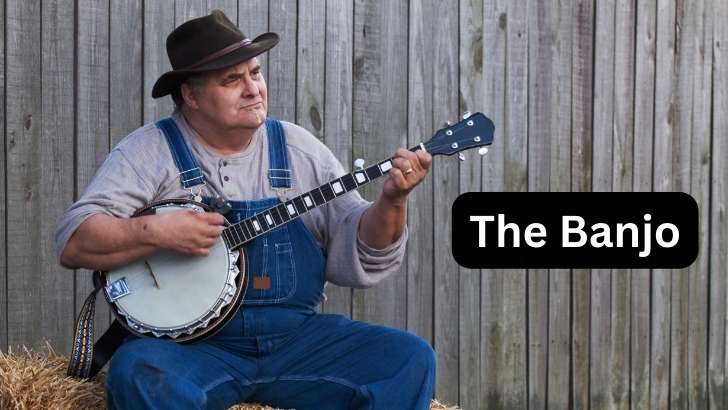
What is a Banjo Musical Instrument : Fast Facts
A banjo is a stringed musical instrument with a distinctive round body and a long neck. It features a drum-like membrane stretched over a frame, producing a unique twangy sound.
Banjos come in various types, including the 5-string banjo, commonly used in bluegrass music, and the 4-string banjo, favored in jazz and Irish music.
A person who plays the banjo is known as a banjo player or banjoist.
In this beginner’s guide, we’ll review what the banjo musical instrument is by examining what it sounds like, how it’s played, its long history, how its made, and also explore some of the great tunes and compositions it has produced over its long and varied musical history.
Search the Table of Contents or watch the video below to get started on our
banjo instrument guide.
How to Play the Banjo Instrument
Playing the banjo involves a combination of manual dexterity, rhythmic sense, and musicality.
The instrument is held in front of the player, who uses the right hand for strumming or picking the strings while the left hand presses down on the strings along the fretboard to change the pitch.
Sound is generated from the banjo in a fascinating way; the strings vibrate when plucked, transferring their vibrations to the membrane (or head) stretched across the body of the instrument. This membrane amplifies the sound, creating the banjo’s characteristic bright and resonant tone.
Fingerpicking Style
The most common playing technique for the banjo is the “rolling” fingerpicking style, especially prominent in bluegrass music. This method involves the player using the thumb, index, and middle fingers of the right hand to play a series of rapid, intricate patterns, allowing for a continuous flow of notes.
Clawhammer Technique
Another popular style is the “clawhammer” technique, where the player strikes the strings in a down-picking motion with the back of the fingernail, then plucks an individual string with the thumb, producing a rhythmic and melodic pattern.
The banjo’s sound can also be altered by the player’s technique and the instrument’s setup. For example, adjusting the tension of the head can change the tone, making it brighter or warmer. Similarly, the material of the strings (whether they are made of nylon, steel, or gut) and the type of picks used (plastic, metal, or none at all) can significantly influence the sound.
Learning to play the banjo involves mastering basic chords and scales, developing a repertoire of picking patterns or strumming techniques, and integrating these elements into songs or pieces.
As players advance, they explore more complex techniques, such as melodic and single-string styles, which allow for greater expression and musical exploration.
The physical interaction between the player and the banjo, from the precise finger movements to the strumming patterns, creates a rich tapestry of sounds that can convey a wide range of emotions and stories through music.
Different Types of Banjo to Learn
There are several types of banjos, each with its unique characteristics, offering various pros and cons for learners. Below is a list of these types along with short summaries of their advantages and disadvantages:
5-String Banjo
Pros: Ideal for bluegrass and folk music, it offers a classic banjo sound with a versatile range for picking and strumming. Cons: The fifth string can be challenging for beginners to get used to, and it is less versatile for other music genres.
4-String Tenor Banjo
Pros: Popular in jazz and Irish music, it’s easier for beginners due to fewer strings and a shorter neck. Cons: Limited range for playing bluegrass or folk styles compared to the 5-string banjo.
Plectrum Banjo
Pros: Similar to the 4-string but played with a plectrum, offering a bright sound ideal for jazz and Dixieland music. Cons: Not suitable for fingerpicking styles, limiting its use in genres like bluegrass.
6-String Banjo (Banjitar)
Pros: Tuned like a guitar, it allows guitarists to easily transition to banjo without learning new fingerings. Cons: Lacks the authentic banjo sound that comes from traditional playing styles, potentially disappointing purists.
Open Back Banjo
Pros: Produces a softer, mellower sound preferred in folk and old-time music, lighter in weight. Cons: Lacks the volume and brightness of resonator banjos, making it less ideal for loud or outdoor settings.
Resonator Banjo
Pros: Features a resonator that projects the sound forward, making it louder and brighter, perfect for bluegrass bands. Cons: Heavier and typically more expensive than open-back banjos, which might be a consideration for beginners.
Banjo Instrument Parts
The banjo, with its distinctive sound and appearance, consists of several key parts made from a variety of materials. Understanding these components is essential for appreciating the instrument’s construction and the nuances of its sound production.
The banjo is made up of several key parts, each contributing to its unique sound and functionality. The primary components include:
- Banjo Head: The head of the banjo acts as the instrument’s sound-producing membrane, similar to the skin on a drum. Traditionally, banjo heads were made from animal hide, offering a warm, authentic tone. Modern banjos, however, frequently use synthetic materials like Mylar, which provide a consistent sound quality and durability under varying conditions.
- Banjo Body (Pot): The body, or “pot,” of the banjo is the circular part that houses the head. It can be made from wood, metal, or composite materials. Wooden bodies, often crafted from maple or mahogany, offer a warmer, richer sound. Metal bodies, typically made from aluminum or brass, produce a brighter tone with more projection.
- Banjo Rim: The rim is part of the body that supports the head, contributing to the instrument’s overall tone. It can be made from wood or metal, with the choice of material affecting the resonance and volume of the banjo.
- Banjo Tone Ring: Positioned between the head and the body, the tone ring significantly influences the banjo’s sound. Made from brass, steel, or bronze, it can enhance brightness, volume, and clarity, adding to the instrument’s characteristic twang.
- Banjo Bridge: The bridge transmits the vibrations from the strings to the head, playing a crucial role in sound production. It’s typically made from maple with an ebony top, balancing strength and the ability to transfer sound efficiently.
- Banjo Neck: The neck of the banjo, where the fretboard is located, is usually made from hardwoods like maple or mahogany. The choice of wood affects the instrument’s durability and the warmth of the sound.
- Banjo Fretboard: Attached to the neck, the fretboard is where the player presses down the strings to change pitches. It’s often made from ebony or rosewood, materials chosen for their hardness and smooth texture, facilitating ease of play.
- Banjo Strings: Banjo strings can be made from nickel, stainless steel, or nylon, each material offering distinct sound qualities. Nickel strings produce a bright, clear tone; stainless steel strings are louder and brighter; and nylon strings offer a softer, mellower sound, often preferred for classical and folk music.
- Banjo Tuning Pegs: The tuning pegs, or tuners, located at the headstock, are used to adjust the tension of the strings, thereby tuning the instrument. They can be made from metal or plastic, with geared tuners providing more precise tuning adjustments.
Each part of the banjo, from the head to the tuning pegs, contributes to the instrument’s unique sound. The materials used in construction play a significant role in defining the tonal character and playability of the banjo, making it a versatile instrument capable of producing a wide range of musical expressions.
Origins of the Banjo: Tracing Back to African Roots
Fast Fact : The name “banjo” traces its origins back to the early 17th century, stemming from African languages. Words like “banjar,” “bangie,” “banza,” or “bandora” were used by African slaves in the Caribbean and the United States to describe similar stringed instruments brought from Africa or made in the New World.
An Overview of Banjo History and Development
| Period | Development |
|---|---|
| 17th Century | Originated in Africa, early banjos were made from hollowed-out gourds with animal skin stretched over them for the head, and used by African slaves in the Caribbean and America. |
| 18th Century | The banjo evolved in America, gaining popularity and beginning to resemble the modern instrument with a wooden frame. |
| 19th Century | Became widely popular in minstrel shows; construction evolved to include a closed back (resonator) for more volume and metal strings for durability and a brighter sound. |
| Early 20th Century | Banjos were essential in jazz bands, leading to the development of the four-string tenor banjo. |
| Mid 20th Century | The 5-string banjo gained prominence in bluegrass music, featuring a high G string. Innovations like the resonator and geared tuners improved sound and playability. |
| Late 20th Century | Introduction of synthetic materials for heads and various modern materials for other parts of the banjo to enhance sound quality and durability. |
| 21st Century | Continued innovation with electronic banjos and further refinement of traditional acoustic models for use in a wide range of musical genres beyond bluegrass and folk, including classical and rock. |
The story of the banjo begins not on the American continents, but across the ocean, in the rich musical traditions of Africa. This instrument, which has become synonymous with American folk and bluegrass music, has its roots deeply embedded in African culture, where music served not just as entertainment, but as a crucial means of communication and community bonding.
The African Precursors
The banjo’s ancestors can be traced back to several African instruments, such as the akonting, ngoni, and xalam. These instruments featured a similar construction to the early banjos, with a body made from a gourd and strings that were plucked to produce sound. The akonting, from the Jola tribe of present-day Senegal and Gambia, is particularly noted for its striking resemblance to the banjo, suggesting a direct lineage.
Transatlantic Journey
The banjo’s journey to the Americas is a testament to the resilience of African culture amidst the horrors of slavery. Enslaved Africans brought with them the knowledge of these instruments, creating early banjos as a means of preserving their heritage and coping with the brutal realities of life in the New World. These handmade instruments became a vital part of slave communities, used in various ceremonies, storytelling, and to express the sorrows and hopes of a displaced people.
Adaptation and Evolution
As the banjo took root in America, it began to evolve. The original gourd body was sometimes replaced with more durable materials, and the number of strings varied. By the 19th century, the banjo had become popular in minstrel shows, albeit often through caricatures of African American culture. Despite this, the instrument played a key role in the development of American music, bridging cultures and influencing the emerging styles of folk, country, and bluegrass.
A Symbol of Cross-Cultural Exchange
The banjo stands as a poignant symbol of cross-cultural exchange, a reminder of the complex history of American music and its African origins. Its evolution from an African instrument to a staple of American music highlights the indelible impact of African culture on the musical landscape of the United States.
The Legacy Continues
Today, the banjo is celebrated for its rich, twangy sound and its ability to convey a range of emotions, from joy to melancholy. Its presence in contemporary music across various genres is a testament to its versatility and enduring appeal. As we appreciate the modern banjo, it’s essential to acknowledge and honor its African roots, which have allowed it to become the beloved instrument it is today.
The Banjo in American Music: A Symbol of Folk and Bluegrass
The banjo’s arrival in America marked the beginning of a significant chapter in the instrument’s history, ultimately becoming a defining symbol of folk and bluegrass music. This transition was not immediate but evolved through the instrument’s adaptation to new environments and cultural contexts.
Adaptation to American Culture
As the banjo was introduced into American society by African slaves, it began to be noticed by other communities, particularly in the South. The instrument’s distinctive sound quickly found its place in the evolving music scene, adapting to the musical tastes and styles of the time.
By the mid-19th century, the banjo had become popular among white musicians, who began to include it in minstrel shows, albeit with significant racial stereotypes attached to its performance.
Rise in Folk and Bluegrass
The real transformation of the banjo’s image began in the early 20th century, as it became a staple in folk and bluegrass music. Its unique sound, capable of both rhythmic drive and delicate melody, made it perfect for the storytelling nature of folk music and the fast-paced, energetic style of bluegrass.
Musicians like Earl Scruggs revolutionized banjo playing with the three-finger picking style, which became synonymous with bluegrass music.
The Banjo’s Cultural Significance
In folk and bluegrass circles, the banjo is more than just an instrument; it’s a symbol of American history, tradition, and the blending of cultures. Its presence in music festivals, jam sessions, and recordings continues to evoke a sense of nostalgia and connection to the past, while also celebrating the instrument’s ongoing evolution.
Influence on Other Genres
Beyond folk and bluegrass, the banjo has made its mark on a variety of other musical genres, from country to indie folk, and even jazz. Its versatility has allowed it to transcend its initial associations and become a beloved instrument among musicians of all backgrounds.
Preservation and Innovation
Today, the banjo is celebrated both for its historical significance and its adaptability. Organizations and musicians alike work to preserve the traditional techniques of banjo playing, while also exploring new ways to incorporate its sound into contemporary music.
The banjo’s journey from African roots to American icon highlights the dynamic nature of musical evolution and the instrument’s enduring appeal.
Technical Evolution: From Gourd to Modern Banjos
The banjo’s journey from its African roots to becoming an icon of American music is not just a story of cultural transformation but also one of significant technical evolution. This evolution has seen the banjo transition from simple gourd instruments to the sophisticated, highly crafted musical devices we see today.
Early Innovations
The earliest banjos, brought to America by enslaved Africans, were made from hollowed-out gourds with animal skin stretched over them to create a resonating chamber, and strings made from various materials. These instruments were fundamental, yet they laid the groundwork for what the banjo would become.
The Minstrel Era
As the banjo gained popularity in the 19th century, particularly within minstrel shows, the need for a louder instrument that could project in larger venues led to significant innovations. The introduction of the drum-like tensioned head, which replaced the gourd, was a crucial development, as was the addition of the fifth string, giving the banjo its distinctive sound.
The Rise of Banjo Manufacturing
The late 19th and early 20th centuries saw the rise of banjo manufacturing, with companies like S.S. Stewart leading the way in creating banjos that varied in size, tone, and design. This era also introduced the resonator, which further amplified the banjo’s sound, making it a favorite among professional musicians, especially in the burgeoning genres of folk and bluegrass.
Modern Advances
Today’s banjos are a testament to the instrument’s continuous innovation. Modern materials like synthetic heads and adjustable necks allow for greater durability and playability.
The range of banjos has expanded to include variations like the four-string tenor banjo, popular in jazz; the six-string banjo, tuned like a guitar for ease of transition for guitarists; and the electric banjo, which opens up new possibilities in sound.
Preserving Tradition While Embracing Innovation
Despite these advances, the banjo’s design still pays homage to its origins. Many players and makers emphasize the importance of traditional craftsmanship, using natural materials and hand-crafted techniques to create instruments that resonate with the banjo’s storied past. At the same time, the banjo community embraces innovation, constantly seeking ways to enhance the instrument’s versatility and appeal.
Conclusion
The technical evolution of the banjo, from a simple gourd instrument to the modern marvels crafted by today’s luthiers, mirrors the instrument’s journey through history. Each innovation reflects changes in musical styles, player preferences, and technological advancements, ensuring that the banjo remains a vital and vibrant part of the musical landscape.
Influential Banjo Players and Their Legacy
The banjo’s rich history is not only a tale of its evolution as an instrument but also a story of the remarkable musicians who have shaped its sound and legacy. These influential players have not only mastered the banjo but have also pushed its boundaries, introducing new styles and techniques that have forever altered the course of music.
Earl Scruggs and Bluegrass Revolution
Perhaps no name is more synonymous with the banjo than Earl Scruggs. His innovative three-finger picking style, often referred to as “Scruggs style,” revolutionized the way the banjo was played. This technique became a cornerstone of bluegrass music, propelling the genre to new heights and solidifying Scruggs’s place in musical history.
Béla Fleck and the Banjo’s Versatility
Béla Fleck has taken the banjo beyond its traditional roots, exploring a multitude of genres from classical to jazz, and everything in between. Fleck’s virtuosity and willingness to experiment have showcased the banjo’s versatility and have earned him multiple Grammy awards across various categories.
Rhiannon Giddens and Cultural Heritage
Rhiannon Giddens, with her deep roots in folk music and her scholarly approach to the banjo’s history, highlights the instrument’s African American heritage. Her work, both as a solo artist and with the Carolina Chocolate Drops, has been pivotal in reasserting the banjo’s place in African American music and culture.
Pete Seeger and Folk Activism
Pete Seeger used the banjo to sing of social injustice and to rally for change, embodying the spirit of American folk music. His iconic song “This Land is Your Land” and his long-neck banjo became symbols of protest and unity, showing how music can inspire and bring about social change.
Abigail Washburn and Cross-Cultural Exchange
Abigail Washburn has bridged the gap between the banjo’s American roots and Chinese musical traditions, creating a unique blend of sounds that celebrate cross-cultural exchange. Her work demonstrates the banjo’s ability to transcend cultural barriers and connect people through music.
These influential banjo players, among many others, have left an indelible mark on music. Through their innovative techniques, cultural explorations, and passionate performances, they have enriched the banjo’s legacy and ensured its place in the future of music.
The Banjo in Popular Culture: Iconic Tunes You’ll Recognize
The banjo, with its distinctive twang and upbeat rhythm, has left an indelible mark on popular culture, making appearances in film, TV, and music that have cemented its place in the auditory landscape of audiences worldwide. Here are seven tunes featuring the banjo that have become widely recognized, transcending genres and eras.
Dueling Banjos
Composed by Arthur “Guitar Boogie” Smith in 1955, “Dueling Banjos” became emblematic of banjo music’s cinematic power after its feature in the 1972 film “Deliverance.” Its engaging duel between guitar and banjo captures a tension that’s as palpable as the movie’s narrative, showcasing the instrument’s dynamic range.
The Ballad of Jed Clampett
Earl Scruggs crafted “The Ballad of Jed Clampett” for the 1962 television series “The Beverly Hillbillies,” embedding the banjo in the heart of American TV culture. This tune exemplifies the banjo’s ability to convey storylines, in this case, the Clampett family’s rags-to-riches tale, with Scruggs’ lively picking style.
Foggy Mountain Breakdown
Originally composed by Earl Scruggs in 1949, “Foggy Mountain Breakdown” gained broader popularity through Steve Martin’s television performances in the 1970s and 1980s. The tune is a testament to the banjo’s versatility, stretching beyond its bluegrass roots to appeal to a wide audience.
Green Acres Theme
Vic Mizzy’s composition for the “Green Acres” theme song, while not primarily a banjo piece, utilized the instrument to accentuate the show’s rural comedy. The banjo segments within the theme reinforced the juxtaposition of country life against urban sophistication, highlighting the banjo’s comedic and light-hearted potential.
I Am a Man of Constant Sorrow
The soundtrack of “O Brother, Where Art Thou?” released in 2000, prominently features the banjo, especially in “I Am a Man of Constant Sorrow” by the Soggy Bottom Boys. This arrangement brought bluegrass and American folk music to a new generation, showcasing the banjo’s enduring appeal.
Little Lion Man
Mumford & Sons’ “Little Lion Man” from 2009 introduced the banjo to a broader, perhaps younger audience, blending it with folk-rock elements. The song exemplifies the instrument’s adaptability, proving its relevance in contemporary music genres.
Dirty Old Town
The Pogues’ rendition of “Dirty Old Town,” written by Ewan MacColl in 1949, features the banjo to evoke a sense of rustic nostalgia. This song highlights the banjo’s role in conveying authenticity and emotion, even within the context of Irish music.
Instruments Similar to a Banjo
While the banjo itself has a rich history and diverse styles, there are several other traditional instruments from acros the world which are closely related to it that share some characteristics but also possess their own unique features.
Here are five more instruments closely related to the banjo which we think you might find of interest:
Mandolin
The mandolin, with its pear-shaped body and four pairs of strings, is often used in classical, bluegrass, and folk music. Originating from Italy in the 17th century, the mandolin produces a bright, resonant sound that can be plucked or strummed. Its compact size and expressive range make it a favorite among musicians seeking a versatile instrument.
Ukulele
The ukulele, hailing from Hawaii in the 19th century, is known for its small size and four nylon strings, which contribute to its light, cheerful sound. It became popular in the United States during the early 20th century and is often associated with Hawaiian music. The ukulele is easy to learn, making it an ideal instrument for beginners.
Dulcimer
The dulcimer, specifically the Appalachian or mountain dulcimer, is a stringed instrument from the United States, with roots in the early 19th century. It features a long, fretted soundboard and is typically played on the lap by strumming or picking. The dulcimer produces a soft, melodic sound, and its simple design makes it accessible for novice musicians.
Balalaika
The balalaika is a Russian stringed instrument with a triangular body and three strings, dating back to the 17th century. It comes in various sizes, from the small prima to the large contrabass, and is primarily plucked. The balalaika is central to Russian folk music, offering a range of sounds from deep and resonant to bright and percussive.
Sitar
The sitar, a plucked stringed instrument from India, is known for its complex sound and intricate design, featuring a long neck with 18-20 movable frets and a gourd-shaped body. It plays a prominent role in Hindustani classical music and became popular worldwide in the 1960s through its association with psychedelic rock. The sitar’s distinctive drones and overtones are achieved through its sympathetic strings, which resonate with the main strings.
Conclusion: Celebrating the Banjo’s Timeless Journey
As we’ve explored the banjo’s rich history, from its African origins to its status as a beloved instrument in American music and beyond, it’s clear that the banjo is more than just a musical instrument. It’s a symbol of cultural resilience, innovation, and the enduring power of music to bring people together.
The banjo’s journey through time reflects the changing landscapes of music and society, adapting and evolving while maintaining its unique voice and charm.
The evolution of the banjo, marked by technical advancements and the creative genius of influential players, showcases the instrument’s versatility and its ability to transcend genres and borders. Today, the banjo continues to inspire musicians and audiences alike, finding its place in a wide array of musical styles and cultural expressions. Its presence in contemporary music, from folk and bluegrass to pop and electronic, speaks to its ongoing relevance and appeal.






